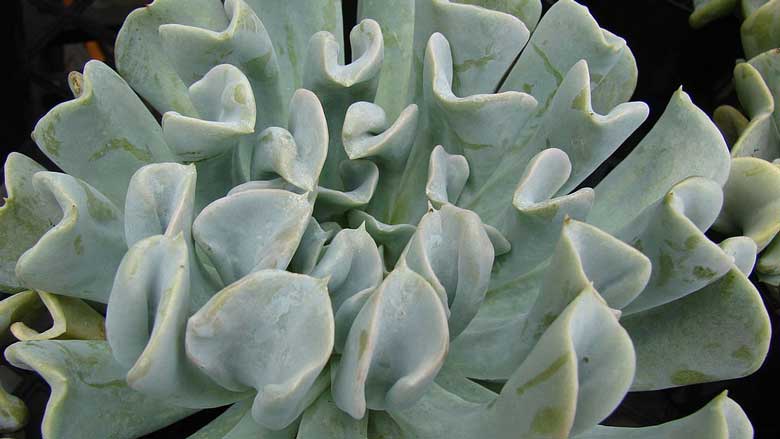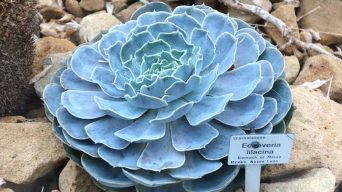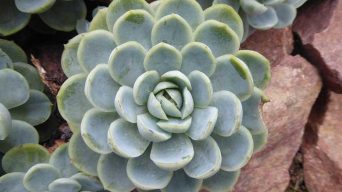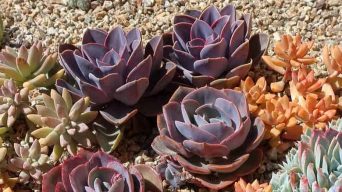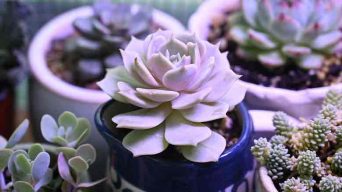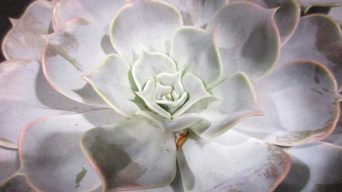Growing succulents is not only rewarding due to their low maintenance but also because they are beautiful and extremely diverse.
One of the most popular types is Echeveria. Even though it is a large genus with more than 150 species, only a few are widely known and commonly cultivated.
However, one really stands out from these common ones – Echeveria runyonii ‘Topsy Turvy’.
Echeveria runyonii ‘Topsy Turvy’ is a cultivar of the Echeveria runyonii succulent plant. Its unique appearance makes it an excellent choice for many indoor and outdoor garden designs.
Echeveria runyonii ‘Topsy Turvy’ care is not difficult at all since this species is pretty tough. However, it does have specific requirements for its growth.
This article will focus on how to care for Echeveria runyonii ‘Topsy Turvy’ and how to propagate this particular species of Echeveria succulent plants.
Overview
The Topsy Turvy plant is an Echeveria runyonii cultivar, a flowering plant in the Crassulaceae family.
Echeveria runyonii ‘Topsy Turvy’ develops rosettes of leaves that may grow 8 to 12 inches (20.5 to 30.5 cm.) tall and wide.
The leaves are silvery green and have a lengthwise fold that exposes the edges. In contrast, the leaves curl upward and toward the middle of the rosette.
The Topsy Turvy Echeveria will bloom in the summer or fall, producing a tall inflorescence with orange and yellow flowers.
How To Care for Echeveria Runyonii ‘Topsy Turvy’
Echeveria runyonii care is pretty straightforward.
Below you’ll find the essential information you need to know about caring for Echeveria runyonii ‘Topsy Turvy’.
Sun Exposure & Light Requirements
Echeveria runyonii ‘Topsy Turvy’ plants thrive in full sun to partial shade and need approximately six hours of bright, direct light per day.
It’s best to place the plants near a west-facing or east-facing window that gets plenty of bright, indirect light.
Echeveria runyonii ‘Topsy Turvy’ does not tolerate intense direct sunlight and burns in more than six hours of direct sun.
Echeveria runyonii ‘Topsy Turvy’ plants can be moved outdoors once the weather begins to warm (in zones 10+) but avoid placing them in intense, unobstructed sunlight during the hottest parts of the day.
Watering Requirements
Echeveria runyonii ‘Topsy Turvy’ plants should be watered once a week or as needed.
Let the soil dry out completely before re-watering, and never allow the pots to sit in water under any circumstances.
To water Topsy Turvy Echeveria plants, place them in a sink or container filled with water and allow the topsoil to absorb the water thoroughly.
Allow any excess water on the bottom of the pot’s saucer to drain out, and never allow the plants to sit in water under any circumstances.
Using a watering can or garden hose, you can also water your Echeveria runyonii ‘Topsy Turvy’ houseplants by hand (always running room-temperature tap water).
Just make sure that the topsoil is fully dry before re-watering.
Soil Requirements
The Echeveria Runyonii ‘Topsy Turvy’ succulent plant thrives in a well-draining cactus/succulent potting mix.
To ensure good drainage, mixing 1 part sand, 1 part potting soil and 1 part perlite is a good idea.
Avoid using garden soil, potting soil, compost, manure, or peat moss in your mix, as they will make your Echeveria runyonii ‘Topsy Turvy’ plant too wet and prone to rot.
Temperature and Humidity
Desert species such as the Echeveria runyonii ‘Topsy Turvy’ succulent plant enjoy hot, dry conditions.
The ideal temperature range for Echeveria runyonii ‘Topsy Turvy’ succulent plants is between 168° – 80° Fahrenheit (20 – 27°C) during the day and anywhere between 55° – 80° Fahrenheit (12 – 27°C) at night.
Echeveria runyonii ‘Topsy Turvy’ succulent plants do not like humidity, but they will survive in humid conditions depending on how high their exposure to direct sunlight is.
They are more likely to rot when exposed to a lot of humidity.
For most Echeveria runyonii ‘Topsy Turvy’ succulent plants, the ideal environment is a warm room with bright light and low humidity.
Fertilizing
Echeveria runyonii ‘Topsy Turvy’ succulents do not require a lot of fertilizing.
However, they can benefit from occasional fertilization in the growing season and will generally respond by producing more leaves and flowers.
Additionally, feeding a half-strength balanced liquid plant fertilizer diluted once or twice a month will support healthy growth.
A slow-release granular fertilizer can also be applied at the beginning of the growing season to promote new leaf and flower growth.
Potting and Repotting
The Topsy Turvy Echeveria is an excellent potted houseplant but has to be repotted regularly (about once every couple of years) to help it grow strong and healthy.
When repotting your plant, make sure to use a pot with drain holes in the bottom.
This is because Topsy Turvy Echeveria does not like to be waterlogged and needs good drainage to thrive.
The plant will also need a pot that is only slightly bigger than the current one, as this species does not like large pots or much root space.
Terracotta or unglazed pots are recommended as they will give the plant healthy drainage.
Repot your Echeveria Runyonii ‘Topsy Turvy’ during the growing season (spring to early summer) when it is actively growing and feeding.
If you repot this plant too early, its roots will not have fully developed, and the root system may be damaged; if you’re too late, the plant may lose its healthy growth.
Pruning
Echeveria runyonii ‘Topsy Turvy’ is a unique succulent plant because it has leaves that grow in two opposite directions.
This can be pretty to look at, but for the plant’s health, you should occasionally prune the Topsy Turvy to remove older leaves and encourage new growth.
To prune this plant, pinch off any dead or dying leaves at the point where they attach to the plant’s stem.
You can also cut back on any brown, dry, or shriveled leaves you see on Echeveria runyonii.
You can also shape it to make it less bushy and more compact.
Simply pinch off any leaves growing in the plant’s center or middle. This will encourage new growth to form on the outer edges of the plant.
You can also pinch off any leaves that are growing too close to one another.
Pruning Echeveria plants helps encourage new growth, which leads to a fuller, healthier, and more colorful succulent.
Pests
Echeveria runyonii ‘Topsy Turvy’ succulent plants are less prone to pests than other succulents. However, they have occasionally fallen prey to mealybugs and scale.
Mealybugs are small, annoying insects that you can find on many succulent plants. They are typically difficult to notice until their population has grown very large.
Mealybugs look like tiny white fuzzballs crawling around your plant. It is easy to remove them with tweezers or a cotton swab dipped in rubbing alcohol if they are spotted early.
Scale is another insect that can afflict succulent plants, though they are harder to spot because of their flat bodies. They look like little brown bumps on the leaves and stems of a plant.
If you find either of these pests on your Echeveria runyonii ‘Topsy Turvy’ succulent plant, simply remove them with tweezers or a cotton swab dipped in rubbing alcohol.
It is much easier to treat succulents for pests before infestations have gotten out of control.
These bugs can spread from plant to plant very quickly, so it is essential to get them under control as soon as possible.
If your succulent is already severely infested with mealybugs or scale, you can quickly use insecticidal soap to get rid of that population.
However, this should be a last resort because it can damage the leaves on your plant.
Neem oil is another natural pesticide option if pest infestations are a real problem for you.
Neem oil is a natural pesticide derived from the neem tree, and it is much safer than using harsh chemicals on your succulent plants.
Diseases
A few diseases afflict Echeveria runyonii ‘Topsy Turvy’ succulents.
The most common disease is root rot, and it can be caused by poor drainage and overwatering. If your plant’s leaves begin to droop or curl, that may be a sign of root rot.
They are also susceptible to fungal disease. If you see brown spots forming on your succulent’s leaves, they are likely infected with some sort of fungus.
Fungal infections can happen if your succulent is not getting enough air circulation or direct sunlight. Make sure that your plant has plenty of space around it to grow new leaves and remove dead ones.
Mealybugs often spread fungal infections from plant to plant, so make sure you remove all of the mealybugs on your succulents. If your plant is already infected with fungus, use neem oil to kill the fungus.
Insecticidal soap can treat fungal infections if they are mild, but if your plant is severely infested with a fungus, you should remove it from its pot and cut away all of the infected parts before returning it to its pot.
You may also consider repotting it in new soil because old potting soil can harbor fungus and pests.
When your succulent plant is infected with any of these diseases, it is important to quarantine it away from your other succulents.
This will prevent the disease from spreading and protect your healthy plants.
Always treat a diseased plant as soon as you notice symptoms and before infections progress too far.
How to Care for Echeveria Runyonii ‘Topsy Turvy’ in Winter
Echeveria Runyonii ‘Topsy Turvy’ succulent is hardy in USDA zones 9 to 11 but can be brought indoors (out of the frost) for winter in most climates.
Move it into a sunny window, where temperatures are around 70°F (21°C) during the day and no lower than 55 to 60°F (13 to 16°C) at night.
Water the plant only when it is dry and let it dry completely between watering.
Reduce watering during the winter. During warmer days, move your plant outside and let it get some sun (a little bit of direct summer sun).
Keep in mind that this is a summer grower but can survive overwintering just fine if brought indoors before heavy frost conditions hit.
How To Propagate Echeveria Runyonii ‘Topsy Turvy’
Echeveria Runyonii ‘Topsy Turvy’ plants can be propagated by leaf cuttings or offsets.
How To Propagate ‘Topsy Turvy’ By Leaf Cuttings
To propagate ‘Topsy Turvy’ by leaf cuttings, remove a leaf from the plant and place it in an area that receives bright indirect light.
Allow the leaf to callous for a few days before laying it on top of moist potting soil in a container.
Cover the leaf with more moist soil and keep the mixture damp.
Once the leaf has rooted into the soil, it can be planted in a container with well-draining potting soil.
How To Propagate ‘Topsy Turvy’ By Offsets
Topsy Turvy plants produce offsets along the base of their stems. These are small Echeveria plants growing from the mother plant.
To propagate ‘Topsy Turvy’ by offsets, gently pull the small rosette away from the mother rosette.
Plant the rosette in a container with well-draining potting soil and keep it watered until new growth appears.
The offsets can be transplanted into individual containers when they are 1/2 inch to 3/4 inches tall.
Final Thoughts
Growing succulents is a fun and easy way to maintain a beautiful home or garden, although some plants can be a little more complicated than others.
The Echeveria runyonii ‘Topsy Turvy’ succulent plant is one of the easier plants to grow, though it does need some care.
For this reason, it is recommended for beginners and experienced gardeners alike.
The Echeveria runyonii ‘Topsy Turvy’ succulent plant is an excellent addition to any home or garden and can be grown relatively quickly.

